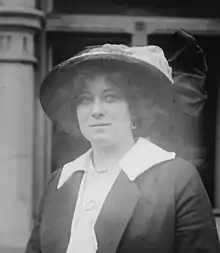Ruth L. Trufant
Ruth Lucille Trufant (née Stuart; 1886 – April 26, 1914) was an American actress and an aspiring opera singer. She was also known by her stage name Maida Athens. She is known for a lawsuit she filed against a married suitor for breach of promise. She died of bichloride of mercury poisoning shortly after she lost the lawsuit in 1914.
Ruth L. Trufant | |
|---|---|
 Trufant c. 1910 | |
| Born | Ruth Lucille Stuart 1886 |
| Died | April 26, 1914 (aged 27–28) New York City, US |
| Other names | Maida Athens |
| Occupation | Actress |
| Years active | 1904 |
| Spouse |
William Trufant
(m. 1902; div. 1903) |
Early life
Ruth Lucille Trufant's father was Judge T. B. Stuart of Denver.[1][2] In 1902, at 16 years old, she attended school in Chicago. She eloped with businessman William Trufant[2] because her parents did not approve of the marriage. The marriage only lasted one year, and she was divorced in 1903. At 17 years old she moved to New York to pursue acting, where she met a hotelman named Henry G. Williams, who was older than 50 at the time. Williams then began a relationship with Trufant.[3]
Career
When Trufant was 17 years old she was an understudy to the leading lady, Miss Fischer, for the play The Tattooed Man.[3] In 1904 she appeared in the plays Babes in Toyland, and It Happened in Nordland as part of the supporting cast.[4] In 1912 she was a music teacher.[3]
Court case
Trufant alleged that Williams had proposed to her on Christmas Day of 1904, asking her to give up her career to be his wife, which she obliged to do. She claimed he continually postponed the wedding with various excuses until May 1907. At this point, she set out for Italy to study opera singing. Williams chased her to Paris and begged her to return to the United States, again promising to marry her. By 1911, Williams finally told her that he had been deceiving her and he could not marry her because he was already married.[3][5]
In 1912, Trufant sued Williams, and The Philadelphia Inquirer ran the headline "Singer Asks $50,000 Balm For Her Heart".[6] In her lawsuit she claimed that one of Williams promises was that he would give her $50,000 for her use once they were married.[6] On April 26, 1913, the story was widely reported, The Atchison Daily Globe took pity on her with a column calling her "trusting and shy", and an "innocent little thing".[7] On April 28, The Evansville Journal's headline read "Her Eyes were Worth $50,000". They also printed a large photo of Trufant and a closeup of her eyes with the statement, "The potent appeal of Mrs. Ruth Trufant's eyes were such that they entranced Henry G. Williams".[8] On April 30, The Buffalo Enquirer reported that she lost her $50,000 lawsuit (equivalent to $1,480,471 in 2022[9]) against Williams.[10]
She appealed her loss in the breach of promise lawsuit against Williams. In early April 1914 she was given the news that her appeal was denied.[1]
Death
Trufant succumbed to the effects of bichloride of mercury poisoning on April 26, 1914. Her death was ruled a suicide.[1][11] The Pittsburgh Daily Post reported that she took the poison one week after losing her appeal in the breach of promise suit against Williams. She was admitted to the Red Cross hospital (now part of the New York University Grossman School of Medicine) and survived for one week.[12]
References
- "Actress Dies of Poisoning When Heart Balm is Denied". The Indianapolis Star. April 27, 1914. Retrieved June 27, 2022 – via Newspapers.com.
- "Poison Fatal to Maida Athens; Tragedy Ends Romantic Career of One of Broadway's Stage Favorites". New-York Tribune. April 27, 1914. p. 14 – via Library of Congress.
- "Jilted Actress Sues New York Hotelman". The Hanford Sentinel. July 19, 1912. Retrieved June 27, 2022 – via Newspapers.com.
- "The Stage". The Courier. November 20, 1904. Retrieved June 27, 2022 – via Newspapers.com.
- "Quit Career Wants $50,000". Pittsburgh Daily Post. October 15, 1912. Retrieved June 27, 2022 – via Newspapers.com.
- "Singer Asks $50,000 Balm For Her Heart". The Philadelphia Inquirer. July 13, 1912. Retrieved June 27, 2022 – via Newspapers.com.
- "Tales of the Telegraph". The Atchison Daily Globe. April 26, 1913. Retrieved June 27, 2022 – via Newspapers.com.
- "Her Eyes Were Worth $50,000". The Evansville Journal. April 28, 1913. Retrieved June 27, 2022 – via Newspapers.com.
- 1634–1699: McCusker, J. J. (1997). How Much Is That in Real Money? A Historical Price Index for Use as a Deflator of Money Values in the Economy of the United States: Addenda et Corrigenda (PDF). American Antiquarian Society. 1700–1799: McCusker, J. J. (1992). How Much Is That in Real Money? A Historical Price Index for Use as a Deflator of Money Values in the Economy of the United States (PDF). American Antiquarian Society. 1800–present: Federal Reserve Bank of Minneapolis. "Consumer Price Index (estimate) 1800–". Retrieved May 28, 2023.
- "Loses $50,000 Suit". The Buffalo Enquirer. April 30, 1913. Retrieved June 27, 2022 – via Newspapers.com.
- The American Library Annual: Including Index to Dates of 1914–1915. New York: R.R. Bowker Company. 1915. p. 155. Retrieved June 27, 2022 – via Google Books.
- "Maida Athens Dies of Poison She Took". Pittsburgh Daily Post. April 26, 1914. Retrieved June 27, 2022 – via Newspapers.com.